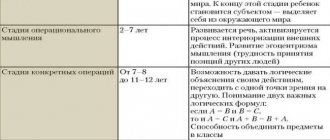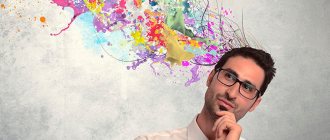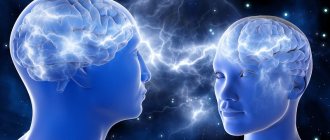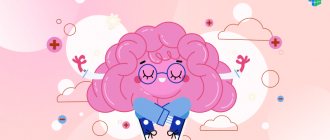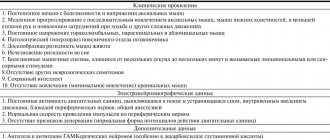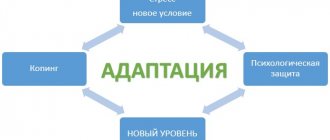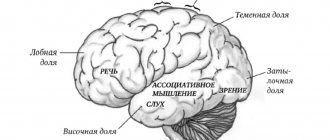Introduction
Cognitive activity is one of the most important aspects of human life. Knowledge of the surrounding world, the laws of objective reality helps a person find his way in it and contributes to the achievement of goals.
Psychology studies the cognitive activity of a particular person in his real life. Psychology deals with sensation and perception as a sensory and objective reflection of the world. In sensation and perception, objects and phenomena are represented by their direct impact on the human sense organs from the side of their external properties. Representation is seen as a form that represents the transition from the sensory stage of cognition to rational cognition.
The pinnacle of the development of rational knowledge is thinking, which manifests itself in three main forms - concept, judgment, inference. The process of thinking reveals what is not given directly in sensations and perceptions. Thinking reflects the world in its essential contexts and relationships.
Thinking is the highest cognitive process. This is a form of human creative understanding of reality, which gives a result that does not exist either in reality itself or in the subject at any given moment.
Many outstanding psychologists dealt with the problem of studying and forming the thinking process: L.S. Vygotsky, P.P. Blonsky, A.V. Zaporozhets, A.A. Lyublinskaya, P.Yu. Kuznetsov, V.V. Galperin, D.B. Elkonin, L.F. Obukhova, L.A. Wegner et al.
Thinking is the basis of learning, therefore the development of various types of thinking and mental operations is traditionally considered as preparation for educational activities. L.S. Vygotsky wrote that “the development of thinking is central to the entire structure of consciousness and to the entire activity system of mental functions. Closely related to this is the idea of intellectualization of all other functions, that is, their change depending on the fact that thinking at a certain stage leads to the conceptualization of these functions, and that the child begins to have a rational attitude towards his mental activity. Depending on this, a number of functions that acted automatically begin to act consciously and logically. These stages are not only the most important formal stages in the construction of the child’s personality, but are also directly related to the degree of development of thinking, since depending on the system of knowledge in which all the external and internal experience of the child is realized, the mental apparatus with the help of which his external and internal experience is deconstructed, analyzed, connected and processed.”
Thus, the problem of research and timely formation of ideas and concepts underlying thinking is very important, which leads to the choice of the topic of research work: “Thinking as the highest form of cognitive activity.”
The purpose of the test: the study of thinking as the highest form of cognitive activity.
Objectives of the test:
- consider the general concept of thinking in psychology as a mental process;
- discover the physiological basis of thinking;
- determine the basic forms, types of thinking and mental operations;
- study concepts and their formation, as well as the basic properties of the mind.
Thinking as the highest form of cognitive activity
Psychology studies mental phenomena: mental processes, mental states and mental properties.
Mental processes describe three main aspects of human mental life: cognition, emotions and will. Accordingly, mental processes are divided into cognitive processes, feelings and will. Cognitive processes include sensations, perception, memory, thinking, imagination, with the help of which we learn, understand the world and ourselves.
Nature has endowed every person with the ability to understand the world in which he was born:
- The ability to feel and perceive the world around us - people, nature, culture, various objects and phenomena;
- the ability to remember, think, reason;
- the ability to speak and understand the language of other people, etc..;
- ability to pay attention.
All these abilities develop and improve not on their own, but in the active cognitive activity of a person.
The mental processes by which a person understands the world around him, himself and other people are called cognitive processes. These processes include: Sensation, perception, attention, memory, thinking and imagination.
In accordance with the topic of our work, we will take a closer look at such a mental process as thinking.
Life always poses problems that cannot be solved by reasoning only on the basis of the perception of objects and phenomena or by remembering what was perceived before. Answers to many questions have to be sought indirectly, drawing conclusions from already existing similar individual objects, phenomena and facts.
Perception and cognition give us knowledge about the individual -
and real world phenomena. However, such information cannot be considered sufficient. In order for a person to live and work normally, it is necessary that he can predict the consequences of certain phenomena, events or his actions.
Therefore, to make predictions, it is necessary to generalize individual objects and facts and, based on these generalizations, draw conclusions about other individual objects and facts of the same kind. This multi-stage transition - from the individual to the general and again from the general
in the singular - occurs due to a special mental process - thinking.
Thinking is the highest cognitive mental process. The essence of this process is the generation of new knowledge based on a person’s creative reflection and transformation of reality.
Thinking as a special mental process has a number of specific properties and characteristics. The first of these characteristics is a generalized reflection of reality.
A generalized reflection (cognition) of reality is the most important feature of thinking. Human experience may not always provide sufficient material for generalization. People constantly base their activities on common experiences learned from others, generalized and enshrined in language. Generalizations reflect the general and therefore most essential properties of objects and phenomena, their general and therefore natural connections. Through generalization we understand the essence of an object. Only with the help of thinking do we recognize the commonality in objects and phenomena, those natural, essential connections between them that are not accessible to direct sensation and perception and which constitute the essence, the pattern of objective reality. Therefore, we can say that thought is a reflection of regular and significant relationships.
Thus, thinking is a process of indirect and generalized perception (reflection) of the environment.
Another important feature of thinking is that thinking is always associated with solving a specific problem that arises in the process of cognition or practical activity. The thinking process manifests itself most clearly only when a problematic situation arises that requires a solution. Thinking always begins with a question, the answer to which is the goal of thinking. And the answer to this question is not found immediately, but with the help of certain mental operations, during which modifications and transformations of available information occur.
An extremely important feature of thinking is its inextricable connection with language. By highlighting something common in objects and phenomena of the surrounding world, a person denotes it in words. Through a word, a person experiences for the first time something that he has not yet seen (and, perhaps, will never see). Language is a form of thinking. Thoughts are always clothed in linguistic form. Language is not only a form, but also a tool of thinking. By expressing thoughts in an expanded verbal form, we contribute to the success of mental activity. Speaking helps thinking.
Attention and memory
The process of cognition can be represented as a ladder, the ascent along which begins with sensations, then moves on to perception, thinking, imagination and ends at the top, which is creativity. But two cognitive processes stand apart
This is attention and memory. They play an auxiliary role and exist only in connection with other cognitive processes
But on the other hand, no intelligent human activity is possible without them.
Attention
This is the concentration of consciousness on external objects and phenomena or on internal processes. In order to perceive something, we must focus on it, and objects that do not fall into the sphere of attention are simply not noticed by us, that is, they are not included in the process of cognition.
There are two main types of attention: voluntary and involuntary.
Involuntary attention occurs on its own, under the influence of specific stimuli. Such concentration, regardless of our desire, is caused by some strong, bright, unusual objects and phenomena, or those that matter to us and are associated with our interests and needs. Voluntary attention is a conscious activity aimed at maintaining concentration on objects that do not arouse interest.
The significance of these objects is determined by the goals and objectives of the activity, and not by their brightness and unusualness. For example, to concentrate on a complex textbook text, you need to make an effort. Voluntary attention is often difficult, so it is necessary to develop conscious concentration skills.
In psychology, attention is considered both as a dynamic side of cognition and as its guide. It is this process that determines the selectivity of our consciousness, not only in terms of cognition, but also in mental activity in general.
Attention is also associated with increased activity in various centers of the brain and makes any of our activities, including cognitive ones, effective and productive. And the loss of the ability to concentrate and concentrate, the involuntary loss of attention is a serious mental illness.
Memory
You already know that the images that arise in the process of perception are unstable. In order for them to be preserved and become part of experience and material for our thinking, the work of memory is necessary
Just like attention, it is not an independent mental process. There is no memory in its pure form, outside, for example, the processes of perception, which supplies information, or thinking, which works with what is stored in memory
All our experience, including professional and sensory-emotional, is the merit of memory. But it also performs other important functions, not only shaping experience, but also establishing a connection between the present and the past. And having lost his memory, a person, along with his memories and accumulated experience, loses his own personality.
There are 4 interconnected processes in memory:
- memorization;
- storing information;
- its reproduction;
- forgetting.
The latter process is also important not only in the field of cognition, but also for maintaining a person’s emotional balance.
Memorizing and storing data is closely related not only to all cognitive processes, but also to the field of activity. To make knowledge easier to remember and retain longer, it must be included in activities: repetition, comprehension, analysis, structuring, use in practice, etc.
Memory is associative in nature, that is, effective memorization occurs through establishing a connection (association) with information we already have. A very interesting and important conclusion follows from this: the more we know, the easier it is to remember new things.
Thus, cognitive processes are a complex system of mental phenomena that ensure the full existence of a person and his relationship with the outside world.
Physiological basis of thinking
Like all mental processes, thinking is an activity of the brain.
The physiological basis of thinking is temporary neural connections (conditioned reflexes) formed in the cerebral cortex.
These conditioned reflexes are developed under the influence of second signals (words, thoughts), which reflect the real situation, but must necessarily be based on the first signal system (perception, sensations and ideas).
I.I.P. Pavlov wrote that “kinesthetic stimuli coming from the speech organs to the cerebral cortex are second signals, signals of signals.” They represent an abstraction from reality and make possible the generalization that constitutes our additional, especially human, higher thinking...”
That is, the physiological basis of thinking are brain processes of a higher level than those that underlie more elementary mental processes such as feeling. However, there is no consensus on the importance and order of interaction of all physiological structures that make the thinking process possible. Undoubtedly, the frontal lobes of the brain play a significant role in mental activity as one of the options for purposeful activity. Moreover, there is no doubt about the importance of those areas of the cerebral cortex that are responsible for the epistemological (cognitive) functions of thinking. It is also obvious that the verbal centers of the cerebral cortex are involved in the cognitive process.
Unlike perception, sensations and memory, secondary signaling connections are more complex systems that reflect various relationships between objects and phenomena.
In the process of thinking, both signaling systems are closely connected. The second signaling system allows for unlimited orientation in the surrounding world, and through it the “highest human adaptation—science” is created.
However, the second signaling system depends on the first. If words do not have a specific real meaning for a person, if a person cannot correlate them with some specific objects and phenomena, then such words cease to be signals of reality.
Thinking usually takes place only with the participation of both signaling systems, but the leading role belongs to the second signaling system, since the word is a signal richer in content and associated with the processes of abstractions and generalizations.
The difficulty of studying the physiological foundations of thinking is explained by the fact that thinking as a separate mental process does not exist in practice. Thinking is present in all other cognitive mental processes, including perception, attention, imagination, memory and language. All higher forms of these processes are to one degree or another associated with thinking, depending on the stage of development.
Thus, thinking is a complex analytical and synthetic activity carried out by the joint work of both signaling systems. Since thinking is a reflection of reality, generalized through words, the main role in this activity belongs to the second signaling system. Constant and close interaction with the first signaling system establishes an inextricable connection between the generalized reflection of reality, which is thinking, and the knowledge of the objective world through sensations, perceptions and ideas.
Intelligence
When characterizing a person’s thinking, they primarily imply his intellectual abilities
, i.e. those abilities that ensure a person’s “inclusion” in a fairly wide range of activities and situations. These intellectual abilities of a person are primarily associated with such characteristics as:
“mental development” and;
"intelligence".
Under mental development
is understood as the totality of both knowledge, skills, and mental actions formed in the process of acquiring these skills and knowledge.
The most general characteristic of the level of mental development is the preparedness of the functioning of thinking within the limits of the age-related socio-psychological standard
(SPN).
That is, the level of mental development should reflect the most typical, general, characteristic features of mental activity for a given society, relating to both the volume and quality of knowledge and skills, and the stock of certain mental actions. The level of mental development achieved by a person depends on his intellectual abilities. Intelligence (or general mental ability) is not the sum of knowledge and mental operations, but what contributes to their successful assimilation. If intelligence is a condition for the acquisition of knowledge and skills, then mental development characterizes primarily the content, methods and forms of thinking. Intelligence
is a relatively stable structure of abilities, which are based on processes that ensure the processing of information of different quality and its conscious evaluation.
Intellectual qualities
are personality qualities that predetermine the characteristics of the functioning of the intellect.
In practice, the diagnosis of mental development arose as intelligence testing and developed in this direction throughout the first half of the twentieth century. It has even become quite common to use the Stanford-Binet IQ test as a “generalized” symbol of intelligence and level of mental development. Intelligence quotient (IQ)
is a quantitative indicator indicating the overall level of development of an individual’s thinking compared to the sample on which the intelligence test was standardized.
Thought processes
Any thought process is realized in the form of judgments, which are always expressed in words, even if these words are not spoken out loud.
An opinion is a statement about something, an affirmation or denial of a connection between objects or phenomena, between some of their characteristics.
In other words, a judgment is a form of thinking in which something is affirmed or denied. The work of thinking on a judgment, aimed at establishing and verifying its truth, is called argumentation.
We arrive at judgments both directly, when they state what is perceived (“The classroom is quite noisy,” “All the roads are covered with snow,” etc.), and indirectly, by deduction.
Judgments may or may not correspond to reality, therefore a distinction is made between true, false (erroneous) and hypothetical judgments.
Thus, the search for an answer, which cannot be obtained directly from perception or by recalling specific facts, but requires drawing conclusions from acquired knowledge, is a mental activity. And the most significant feature of thought processes is that a person goes beyond his immediate experience. The indirect nature of thinking gives us the opportunity to significantly expand our knowledge of reality. The volume of what we think exceeds the volume of what we perceive. Based on perception, but going beyond its limits, as a result of reflection, we learn the distant past of the Earth, the evolution of fauna and flora, the history of mankind, discover new laws, etc. Following this argument, we can now say that thinking is the indirect knowledge (or reflection) of reality.
However, thinking is not only indirect cognition, but also generalized cognition (reflection) of the surrounding world.
Perceptions and sensations give us knowledge about separate, individual things and phenomena (or their aspects, properties, qualities) of the real world. This knowledge can never be enough. Life and practice require the ability to foresee the results of our actions, the consequences of various phenomena and events that we perceive. Knowing the singular number does not provide a sufficient basis for foresight. Any conclusion, even the simplest one, requires a certain amount of knowledge and generalizations made earlier.
Inference is a form of reasoning that allows a person to draw a new conclusion from a set of propositions. In other words, a new opinion is formed based on the analysis and comparison of existing opinions.
There are two main types of inferences - inductive and deductive, or induction and deduction.
Induction is an inference from particular cases to a general statement.
Deduction is an inference from a general proposition to a specific proposition or from a general statement to a specific case. Both types of inference, induction and deduction, are closely related. Complex reasoning processes always represent a chain of inferences in which both types of inferences are intertwined and interact.
The concept and essence of thinking
Definition 1
Thinking is an intellectual phase in which the brain processes information in order to form a subsequent judgment about an object, phenomenon or situation.
In psychology, thinking is considered as a sequential chain of elements for a person’s processing of certain information.
One of the main features of thinking is its indirect nature and generalizing essence.
The indirect nature of thinking lies in the fact that the individual is not able to think outside of concepts and images. An object or phenomenon is known, as it were, indirectly, through those properties that are known and understandable. Understanding the unknown is carried out through the known.
Thinking is based on the individual’s sensory experience, which consists of sensations, perceptions and ideas. In addition, a person’s existing theoretical knowledge is used in thinking.
Note 1
Thus, indirect knowledge of an object or phenomenon is indirect knowledge. Accordingly, thinking does not involve the acquisition of new knowledge, it consists in the processing and processing of existing knowledge.
The generalizing essence of thinking comes from the first property and lies in comprehension through interrelation with the known.
Generalization as the knowledge of what is essential and general in the objects of the surrounding reality is possible due to the fact that the properties of almost all objects are interrelated with each other. Thus, the general is found in the concrete and separate, but is manifested in the particular.
The generalizations that an individual receives through thinking are expressed by speech (language, words). The verbal expression of a meaningful thing relates not only to a specific object, but also to a group of objects. In addition, images, ideas and perceptions can be generalized. The only limitation that may hinder mental generalization is the lack of clarity. At the same time, verbal generalization is limitless.
Mental operations
Human mental activity is carried out using mental operations: comparison, analysis and synthesis, abstraction, generalization and concretization. All these operations are different aspects of the main activity of thinking - mediation, i.e. identifying increasingly significant objective connections and relationships between objects, phenomena and facts.
Comparison is a comparison of objects and phenomena in order to find similarities and differences between them. When we compare objects or phenomena, we can always find that they are similar in some ways and different in others.
Comparison of things, phenomena, their properties, comparison reveals identity and difference. Comparison reveals the identity of some things and the difference of others, which leads to their classification. The classification is based on a certain characteristic, which, as it turns out, is inherent in each object of a certain group. Thus, in a library, books can be classified by author, content, genre, binding, format, etc. The characteristic on the basis of which classification is made is called the basis of classification.
Analysis and synthesis are the most important operations of thinking that are inseparable. As a whole, they provide complete and comprehensive knowledge of reality.
Analysis is the mental dissection of an object or phenomenon with the aim of composing its parts or mentally highlighting its individual properties, characteristics, qualities. When we perceive an object, we can distinguish one part after another in it and thus determine what parts it consists of. For example, in a plant we distinguish stem, root, flowers, leaves, etc. Analysis in this case is the mental division of the whole into its component parts.
Synthesis is the mental connection of individual parts of objects or the mental combination of their individual properties. If analysis provides knowledge about individual elements, then synthesis, based on the results of analysis that combines these elements, provides knowledge about the object as a whole. Thus, when reading, individual letters, words, and sentences are highlighted in the text, but at the same time they are constantly connected with each other: Letters are combined into words, words into sentences, sentences into separate parts of the text.
Abstraction. Often, when studying a phenomenon, it is necessary to highlight one feature, one characteristic, one part of it for deeper knowledge, distracting (abstracting) for a while from all the others and not taking them into account. Abstraction is the mental exclusion of essential properties and characteristics of objects or phenomena while abstracting from non-essential properties and characteristics. With the help of abstraction we can get abstract concepts - courage, beauty, distance, heaviness, length, breadth, equality, value, etc.
Generalization and specification. Generalization is closely related to abstraction. A person cannot generalize without abstracting from the differences in what he generalizes. It is impossible to mentally unite all the trees without abstracting from the differences between them. Generalization involves combining objects and phenomena based on their common and essential characteristics. Generalization, like abstraction, is carried out using words. Each word refers not to one object or phenomenon, but to a collection of similar individual objects. For example, the concept that we express with the word “fruit” combines similar (essential) characteristics found in apples, pears, plums, etc.
In educational activities, generalization usually manifests itself in definitions, conclusions, rules..... It is often difficult for children to generalize, because they cannot always identify not only general, but also essential common features of objects, phenomena, facts.
Concreteness is the mental representation of something individual that corresponds to a particular concept or general goal. We are no longer distracted by various signs or characteristics of objects and phenomena, but, on the contrary, we try to present these objects or phenomena in a significant completeness of their properties. In principle, the particular is always a reference to an example, an illustration of the general. Specificity plays an important role in the explanations we give to others. This is especially important in the explanations that the teacher gives to the children.
Your psychologist. The work of a psychologist at school.
| Attention |
| Memory |
| Thinking |
| Imagination |
| Emotional and volitional regulation of activity |
| Variety of motives for activity |
| Modern theories of motivation |
| Stages of mastering human activity: knowledge, ability, skills, habits |
| Emotions and feelings |
| Will |
| All pages |
Page 5 of 12
3.2.2 Thinking
| The essence of thinking as a cognitive process. Thinking as mediated cognition. The relationship between thinking and sensory cognition. Physiological foundations of thinking. Two signaling systems for reflecting reality, their relationship in the process of thinking. Types of thinking: visual-effective, visual-figurative and verbal-logical. Forms of thinking: concepts, judgments, conclusions. Mental operations: analysis, synthesis, abstraction, generalization, specification, analogy, comparison. Induction and deduction as ways of knowledge. Depth, breadth, independence, flexibility are individual characteristics of thinking. Thinking and speech. Thinking and intelligence. The connection between thinking and other mental processes |
Sensory cognition gives a person information about nine specific objects in their directly cognizable properties. However, not every phenomenon is accessible to direct sensory perception. For example, a person does not perceive ultraviolet rays, but he, nevertheless, knows about their existence and properties. Such knowledge becomes possible indirectly. This path is the path of thinking. In the most general terms, it consists in the fact that we subject some things to the test of other things and, aware of the established relations of interaction between them, judge by the change we perceive in them about the properties of these things that are directly hidden from us. Thinking is the highest cognitive process. It represents the generation of new knowledge, an active form of creative reflection and transformation of reality by man. Thinking generates a result that does not currently exist either in the activity itself or in the subject. Thinking can also be understood as the acquisition of new knowledge, the creative transformation of existing ideas. The difference between thinking and other psychological processes is also that it is almost always associated with the presence of a problem situation, a task that needs to be solved, and an active change in the conditions in which this task is given. Thinking, unlike perception, goes beyond the sensory data and expands the boundaries of knowledge. In thinking based on sensory information, certain theoretical and practical conclusions are made. It reflects existence not only in the form of individual things, phenomena and their properties, but also determines the connections that exist between them, which most often are not given directly to man in his very perception. The properties of things and phenomena, the connections between them are reflected in thinking in a generalized form, in the form of laws and entities. Thus, thinking is a generalized and indirect reflection of reality by a person in its essential connections and relationships. A generalized reflection of reality, which is thinking, is the result of processing not only the experience of an individual person and his contemporaries, but also of previous generations. A person resorts to indirect cognition in the following cases: - direct cognition is impossible due to our analyzers (for example, we do not have analyzers for capturing X-rays); - direct cognition is possible in principle, but impossible under the given conditions; - direct knowledge is possible, but not rational. Thinking makes it possible to understand the patterns of the material world, cause-and-effect relationships in nature and in socio-historical life, as well as the patterns of the human psyche. The source and criterion of mental reality, as well as the area for applying its results, is practice. In practice, thinking as a separate mental process does not exist; it is invisibly present in all other cognitive processes: perception, attention, imagination, memory, speech. The highest forms of these processes are necessarily associated with thinking, and the degree of its participation in these cognitive processes determines their level of development. The physiological basis of thinking is the reflex activity of the brain, those temporary nerve connections that are formed in the cerebral cortex. These connections arise under the influence of signals from the second system (speech), reflecting reality, but with mandatory reliance on signals from the first system (sensation, perception, ideas). In the process of thinking, both signaling systems are closely connected with each other. The second signaling system relies on the first and determines the continuous connection of the generalized reflection of reality, which is thinking, with sensory knowledge of the objective world through sensations, perceptions, and ideas. Thinking is the movement of ideas that reveals the essence of things. Its result is not an image, but a certain thought, an idea. A concept can be a specific result of thinking. In its development, thinking goes through two stages: - pre-conceptual; - conceptual. Pre-conceptual thinking is inherent in a child under five years of age. It is characterized by insensitivity to contradictions, syncretism (the tendency to connect everything with everything), transduction (the transition from the particular to the particular, bypassing the general), and the absence of the idea of the conservation of quantity (S.L. Rubinstein). Conceptual thinking develops gradually from the child’s simple putting together of objects through the establishment of similarities and differences between them to conceptual thinking, which is formed by the age of 16-17. The human thought process is carried out in two main forms: 1) the formation and assimilation of concepts, judgments and conclusions; 2) solving mental problems. A concept is a form of thinking that reflects the essential properties, connections and relationships of objects and phenomena, which is expressed in a word or group of words. For example, the concept of “person” includes such very significant features as articulate speech, labor activity and the production of tools. Concepts are usually distinguished: - by the degree of abstraction (concrete and abstract); — by volume (single and general). When, from all the characteristics of an object, a certain set of characteristics is identified that characterizes this particular object or a group of similar ones, we are dealing with a specific concept (for example, “city”, “furniture”). If, with the help of abstraction, a certain feature is highlighted in an object and this feature becomes the subject of study and, in addition, is considered as a special subject, then an abstract concept arises (for example, “justice”, “equality”). As a structural unit of thought, a judgment is built on a set of concepts. Judgment is a form of thinking that reflects the connections between objects and phenomena of reality and their properties and characteristics. For example, the Earth revolves around the Sun. Judgments are formed in two ways: directly, when they express what is perceived, and indirectly - through inferences or reasoning. Inference is a form of thinking in which a conclusion is drawn based on several judgments. For example, all the planets in the solar system revolve around the sun. Earth is a planet in the solar system, which means it revolves around the sun. Conclusions can be reached using the following methods: induction, deduction, analogy. Induction is a logical conclusion that reflects the direction of thought from the particular to the general. Deduction is a logical conclusion that reflects the direction of thought from the general to the specific. Analogy is a logical conclusion that reflects the direction of thought from particular to particular. Each act of thinking is a process of solving a problem that arises in the course of human cognition or practical activity. Depending on the style of mental activity of a person and the accessibility of the content of the problem for him, its solution can be carried out in various ways. The least desirable method is trial and error, in which there is usually neither a sufficiently clear understanding of the task nor the construction and purposeful testing of various hypotheses. This method, as a rule, does not lead to the accumulation of experience and does not serve as a condition for human mental development. Methods for solving a mental problem, which not only allow you to quickly find an answer, but are also conditions for a person’s mental development, can be named such as passive and active use of an algorithm, targeted transformation of the conditions of the problem, heuristic ways of solving the problem. The problem solving process consists of five stages: 1. Motivation (desire to solve the problem). 2. Analysis of the problem. 3. Search for a solution to the problem based on a known algorithm, on the basis of choosing the optimal option and on the basis of a fundamentally new solution, taking into account logical reasoning, analogies, heuristic and empirical techniques. The solution to a problem is often facilitated by insight. 4. Proof and justification of the correctness of the decision. 5. Implementation and verification of the solution, and, if necessary, its correction. Thinking, unlike other processes, occurs in accordance with a certain logic. In order to identify objective relationships and interconnections between objects and phenomena during the formation of concepts, judgments, conclusions and solving mental problems, a person resorts to mental operations - compares, analyzes, generalizes and classifies. Accordingly, the following logical operations can be distinguished in the structure of thinking: 1. Comparison - establishing relations of similarity and difference. The result of comparison, in addition, can be systematization or classification - the mental distribution of objects and phenomena into groups and subgroups. Often it acts as the primary form of theoretical and practical knowledge. 2. A deeper penetration into the essence of things requires the disclosure of their internal connections, patterns and essential properties. It is performed using analysis and synthesis. Analysis is the dissection of an object, mental or practical, into its constituent elements and their subsequent comparison. Synthesis is the construction of a whole from analytically given parts. Analysis and synthesis are usually carried out together and contribute to a deeper understanding of reality. “Analysis and synthesis,” wrote S.L. Rubinstein, “common denominators” of the entire cognitive process. They relate not only to abstract thinking, but also to sensory cognition and perception. In terms of sensory cognition, analysis is expressed in the identification of some sensory property of an object that had not been properly identified before. The cognitive significance of analysis is due to the fact that it isolates and emphasizes, highlights the essential.” Theoretical, practical, imaginative and abstract intelligence in its formation is associated with the improvement of thinking operations, primarily analysis, synthesis and generalization. 3. Abstraction is the isolation of any side or aspect of a phenomenon that in reality does not exist as an independent entity. Abstraction is performed for a more thorough study and, as a rule, on the basis of a previously performed analysis and synthesis. The result of all these operations is often the formation of concepts. Not only properties, but also actions, in particular methods of solving problems, can be abstracted. Their use and transfer to other conditions is possible only when the selected method of solution is realized and meaningful regardless of the specific task. 4. Generalization acts as a connection of the essential (abstraction) and connecting it with a class of objects and phenomena. The concept becomes one of the forms of mental generalization. 5. Concretization acts as an operation inverse to generalization. This is a distraction from general characteristics and emphasizing the particular, individual. It is defined, for example, in the fact that from the general definition of a concept a judgment is derived about the belonging of individual things and phenomena to a certain class. All these operations, according to S.L. Rubinstein [65], are different aspects of the main operation of thinking - mediation (that is, the disclosure of increasingly significant connections and relationships). Let's consider the types and types of thinking, and its individual characteristics. There are different approaches to defining types of thinking. • Based on the degree of development of the tasks being solved, thinking is distinguished: - discursive (inferential); - intuitive - instantaneous, characterized by minimal awareness. • Thinking is a kind of theoretical and practical activity that involves a system of actions and operations of an indicative, research, transformative and cognitive nature included in it. Thus, according to the nature of the problems being solved, thinking is divided into: - theoretical (conceptual) conceptual thinking - this is thinking, using which a person, in the process of solving a problem, turns to concepts, performs actions in the mind, without directly dealing with the experience gained with the help of organs feelings. He discusses and searches for a solution to a problem from beginning to end in his mind, using ready-made knowledge obtained by other people, expressed in conceptual form, judgments and inferences. Theoretical conceptual thinking is characteristic of scientific theoretical research. — theoretical figurative thinking differs from conceptual thinking in that the material that a person uses here to solve a problem is not concepts, judgments or inferences, but images. They are either directly retrieved from memory or creatively recreated by the imagination. This type of thinking is used by creative people who deal with images. In the course of solving mental problems, the corresponding images are mentally transmitted so that a person, as a result of manipulating them, can directly see the solution to the problem that interests him. Both types of thinking considered - theoretical conceptual and theoretical figurative - in reality, as a rule, coexist. They complement each other and reveal to a person different but interconnected aspects of existence. Theoretical conceptual thinking provides, although abstract, but at the same time the most accurate, generalized reflection of reality. Theoretical figurative thinking allows us to obtain a specific subjective perception of it, which is no less real than an objective conceptual one. Without one or another type of thinking, a person’s perception of reality would not be as deep and versatile, accurate and rich in various shades as it actually is. - practical, carried out on the basis of social experience and experiment. • Based on the content of the tasks to be solved, the following are distinguished: - objective-effective; - visually figurative; - verbal and logical thinking. Visual-effective thinking is based on the direct perception of objects, the real transformation of the situation in the process of actions with objects. The main condition for solving the problem in this case is the correct actions with the appropriate objects. This type of thinking is widely represented among people engaged in real production work, the result of which is the creation of a specific material product. Visual-figurative thinking is characterized by reliance on ideas and images. Its peculiarity is that the thought process in it is directly related to the thinking person’s perception of the surrounding reality and cannot take place without it. Thoughts are visual and figurative, a person is tied to reality, and the images themselves necessary for thinking are presented in his short-term and operative memory (in contrast, images for theoretical figurative thinking are extracted from long-term memory and then transformed). Its functions are related to the presentation of situations and changes in them that a person wants to obtain as a result of his activities that transform the situation. In contrast to visual-effective thinking, it is transformed only in terms of image (J. Piaget) [60]. This form of thinking is most fully and comprehensively represented among children of preschool and primary school age, and among adults - among people engaged in practical work. This type of thinking is quite developed in all people who often have to make decisions about the objects of their activity only by observing them, but without directly touching them. Verbal-logical thinking is carried out using logical operations with concepts. Within this type, the following types of thinking are distinguished: - theoretical; - practical; — analytical; - realistic; - autistic; - productive and reproductive; - involuntary and voluntary. Theoretical thinking is the knowledge of laws, rules, development of concepts and hypotheses. Practical thinking is the preparation of a transformation of reality (developing a goal, creating a plan, a diagram, testing hypotheses under conditions of severe time pressure). Analytical (logical) thinking is temporary, structural (stage-by-stage) and conscious in nature. Realistic thinking is aimed at the outside world and is governed by the laws of logic. Autistic thinking is associated with the realization of a person’s desires. Productive is reproducing thinking based on novelty in mental activity, and reproductive is reproducing thinking in a given image and likeness. Involuntary thinking involves the transformation of dream images, and voluntary thinking involves the purposeful solution of mental problems. Thinking has a pronounced individual character. The peculiarities of individual thinking are manifested in different relationships of types and forms, operations and procedures of mental activity. Thus, all of the listed types of thinking coexist in humans and can be represented in the same activity. However, depending on its nature and ultimate goals, one or another type of thinking dominates. For this reason they all differ. In terms of their degree of complexity, in terms of the demands they place on a person’s intellectual and other abilities, all of these types of thinking are not inferior to each other. The most important qualities of thinking are: • Independence of thinking - the ability to put forward new problems and find ways to solve them without resorting to the help of other people. • Initiative - a constant desire to seek and find ways and means to solve a problem. • depth - the ability to penetrate the essence of things and phenomena, understand the causes and deep patterns. • LATY - the ability to see problems multilaterally, in conjunction with other phenomena. • speed - the speed of solving problems, ease of reproduction of ideas. • originality - the ability to produce new ideas that are different from generally accepted. • Inquisitiveness is the need to always find the best solution to the tasks and problems. • Criticality is an objective assessment of objects and phenomena, the desire to question the hypothesis and solution. • Hasterness - the imperceptibility of aspects of a comprehensive study of the problem, snatching only individuals from it, a statement of inaccurate answers and judgments. Thinking is required-motivated and focused in nature. All operations of the thought process are caused by the needs, motives, interests of the individual, its goals and objectives. Of great importance are a person’s active desire to develop his intelligence and willingness to actively use him in useful activity. One of the difficult problems of learning at school and a university (especially technical) is the emphasis on the development of formal logical thinking to the detriment of figurative thinking. As a result, students and students become as if enslaved by their own formal-logical thinking: the desire for creativity, high spiritual requests seem completely unnecessary to some of them. It is necessary that both of these types of thinking develop harmoniously so that imaginative thinking does not turn out to be constrained by rationality, so that a person’s creative potential does not run out. According to D. Gilford, creative thinking has the following features [10]: - originality and unusual ideas, their intellectual novelty; - the ability to manifest semantic flexibility, that is, the ability to see an object from a new angle; - figurative adaptive flexibility, that is, the ability to change perception in order to see all aspects of the object hidden from observation; Semantic spontaneous flexibility when comparing various ideas. A serious obstacle to creative thinking is the commitment to old solutions: a tendency to conformism, fear of seeming stupid and funny, extravagant or aggressive; fear of mistakes and fear of criticism; overstated assessment of their own ideas; high level of anxiety; Mental and muscle tension. The conditions of successful solving creative problems are more frequent detection and application of new methods; successful overcoming of the prevailing stereotypes; the ability to take risk, freeing from fear and protective reactions, a combination of optimal motivation and the corresponding level of emotional excitement; The variety and multidirectionality of knowledge and skills that orient thinking to new approaches. Thinking is organically related to speech and language. Their occurrence and development marks the emergence of a new special form of reflection of reality and its management. It is important to distinguish the language from speech [15]. Language is a system of conditional symbols by which combinations of sounds are conveyed that have certain meaning and meaning for people. Speech is a set of pronounced or perceived sounds that have the same meaning and also meaning as the corresponding system of written characters. The language is one for all people who use it, speech is individual. In speech, the psychology of a single person or community of people is expressed for whom these features of speech are characteristic; The language reflects the psychology of the people for whom it is native, and not only now living people, but also previous generations. Speech without assimilation of a language is impossible, while language can exist and develop relatively independently of a person, according to laws that are not related to either his psychology or his behavior. The link between the language and the speech is the meaning of the word, since it is expressed both in the units of the language and in the units of speech. Speech performs a number of functions: - expresses the individual originality of human psychology; - acts as a carrier of information, memory and consciousness; - is a means of thinking; - acts as a regulator of human communication and his own behavior; - It is a means of managing the behavior of other people. The main function of speech in humans is that it is a tool of thinking. In a word as a concept, much more information is contained than can carry a simple combination of sounds. The fact that human thinking is inextricably linked with speech is primarily proved by psychophysiological studies of the participation of the voice apparatus in solving mental problems. In the most complex and intense moments of thinking, a person has increased activity of the vocal cords. Emotional-thought outbreaks, as a rule, cause an increase in speechwriting activity. In these cases, mental operations and speech -related reactions are performed in unity and interdependence. In speech thinking, the word and thought are constantly united. The main path of development of human speech is its inclusion in the management of all cognitive processes and interconnection. Speech is actively developing during training and education. The formation and development of speech occurs during three periods: - phonetic - to assimilate the sound appearance of the word (up to 2 years); - grammatical - to assimilate the structural laws of the organization of the statement (up to 3 years); - semantic - by the assimilation of conceptual assignment (up to 17 years). Consciously and unconsciously selected images of speech behavior are fixed and become familiar in the speech activity of a person. So the style of speech activity is born, characteristic of each person, which largely determines the internal and appearance of his personality. The professional activity of a person has a great influence on the style of speech. The artist is characterized by emotional and expressive speech, for the military-command-war, for the writer-figuratively narrative, for a business person-utilitarian and pragmatic, for the scientist and teacher-conceptual-explanatory. Purposefully engaged in the development of speech, a person increases its culture, increases his erudition, which means he enriches and develops his intelligence. One of the main tasks of psychology is to reveal in each person the reserves of thinking and speech that he does not use, to outline the ways of self -learning and self -development of his creative intelligence. Control questions 1. The essence of thinking as a cognitive process. Thinking as indirect knowledge. Definition of thinking. Thinking and perception. Thinking and speech. Emotions and thinking. 2. Two signaling systems of reflection of reality, their relationship in the process of thinking. 3. Doponical and conceptual thinking. 4. Formation of concepts. 5. Mental operations. Analysis, synthesis, comparison, abstraction, generalization. 6. Thinking in the process of solving problems. 7. Types of thinking. Practical and theoretical thinking. Visual-effective, visual-figurative and conceptual thinking. Surgical thinking. 8. Creative thinking and the problem of intuition. 9. Individual differences in thinking. Mental activity and individual cognitive style. 10. Speech as a cognitive process and speech as a means of communication. 11. General characteristics of speech as a communicative process. The role of the language in communication. 12. Speech functions. 13. The development of speech in ontogenesis.
<< Previous — Next >>
Bibliography
- Large explanatory psychological dictionary / translation from English by R. Arthur. - M.: AST, Veche, 2006 - 560 p.
- Wenger L.A., Ibatulina A.A. The relationship between learning, psychological development and functional characteristics of the maturing brain / L.A. Wenger, A.A. Ibatulina // Questions of psychology. - 2008. - No. 2. - P.5 - 9.
- Galperin P. Ya. Lectures on psychology: a textbook for students / P. Ya. Galperin. Galperin. — 2nd ed. corr. and additional M.: KDU, 2005 - 400 pp., illus.
- Dzheme, U. Psychology / ed. L.A. Petrovsky. - M.: Pedagogy, 2003 - 368 p. (Classics of world psychology).
- Druzhinin, V.N. Psychology of general abilities / V.N. Druzhinin. - St. Petersburg:, 2007 - 368 p.
- Dubrovina I.V. Psychology: textbook for students of secondary educational institutions / I.V. Dubrovina, E.E. Danilova, A.M. Parishioners; edited by I.V. Dubrovina. - M.: Academy, 2008. P.122 - 138, 170 - 180.
- Research thinking in psychology / ed. E.V. Shorokhova. - M.:, 2005 - 214 p.
- Karpenko L.A. Brief psychological dictionary / L.A. Karpenko L.A. edited by A.V. Petrovsky, M.G. Yaroshevsky. - Rostov n/d.: Phoenix, 2008 - 431 p.
- Maklakov A.G. General psychology / A.G. Maklakov. - St. Petersburg: Peter, 2004 - 592 pp.: ill.
- Petrovsky, A.V. Psychology: a textbook for students of higher educational institutions / A.V. Petrovsky, M.G. Yaroshevsky. — 2nd edition, stereotypical. - M.: Academia, 2007 - 512 p.
- Tikhomirov, OK. Psychology of thinking / OK Tikhomirova. — MOSCOW STATE UNIVERSITY, 2005 — 131 p.
